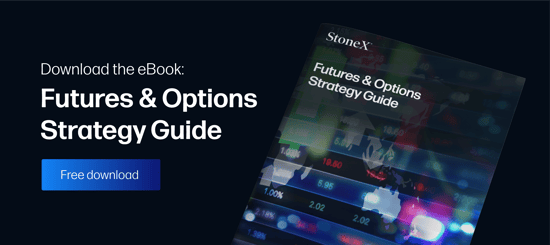In futures trading, traders have two ways to measure profitability: realized and unrealized gain and loss. Realized gains and losses are those that are actually booked to the trading account; unrealized gains and losses are a running tally of a position’s success or failure. For active traders, staying on top of the latter is imperative to competently managing risk in the live market.
How Do Open Positions Impact My Unrealized P&L?
If you’re familiar with sports, then you understand the concept of keeping score. As one side outperforms or lags behind the other, the discrepancy is reflected on the scoreboard. A single trade works much the same way—a position’s success or failure ebbs and flows as price action evolves. This is recorded as unrealized profit and loss (P&L).
A trade’s unrealized gain & loss impacts the trading account in two ways:
- Debit: For trades in a negative position, the trading account is responsible for the drawdown. Unrealized losses are removed or debited from the account balance on a tick-by-tick basis.
- Credit: For trades in a positive position, the trading account is given the benefit. Unrealized gains are allocated or credited to the account balance on a tick-by-tick basis.
Any trades are educational examples only. They do not include commissions and fees.
To illustrate the mechanics of how unrealized P&L influences a trader’s financial health, assume that Gerry the gold trader purchases one lot of December 2021 CME E-micro gold from $1,750. The trade will immediately impact Gerry’s $5,000 account in the following ways:
- An intraday margin of $550 is held from Gerry’s account balance, leaving $4,450 in working capital.
- If price rises above the buy entry of 1750.0, the account is credited $1.00 per tick.
- If price falls beneath the buy entry of 1750.0, the account is debited $1.00 per tick.
- When Gerry closes the position, the trade will be verified and cleared. Subsequently, the unrealized gain and loss will become official and post to the account.
Understanding How Leverage Enhances Unrealized Gain & Loss
Financial leverage is the backbone of the futures markets. It is the basis for margin trading, which gives participants the ability to control large quantities of assets with a minimal capital outlay. Understanding how increased leverage impacts unrealized P&L is a key part of managing positions in live market conditions.
Although implementing high degrees of leverage can produce extraordinary returns, it also magnifies risk. For example, let’s assume that Gerry has an appetite for December E-micro gold and purchases five lots from 1750.0. As you can see, Gerry’s $5,000 account balance is placed under added pressure:
- Gerry’s intraday margin requirements are now $2,750 ($550 x 5). This leaves only $2,250 in working capital.
- If price rallies above 1750.0, an unrealized profit of $5 per tick is credited to the account.
- If price falls beneath 1750.0, an unrealized loss of $5 per tick is debited from the account.
- When Gerry closes out the position, the unrealized gain & loss is officially booked to the account.
Any trades are educational examples only. They do not include commissions and fees.
As you can see from the example, Gerry’s monetary commitment is much larger with five lots than with one lot of December E-micro gold. The enhanced leverage increases the trade’s margin requirements and per-tick liabilities. Instead of having $4,450 in working capital, Gerry now has $2,250. If the market tanks below 1750.0, the unrealized losses from the negative position may trigger the following broker-initiated actions:
- Position liquidation: If unrealized losses take the account balance beneath $2,750, the trade’s margin requirements will be violated. Accordingly, the position may be automatically liquidated at market prices.
- Margin call: In the event that the negative position is not liquidated, Gerry may receive a margin call from the broker. The margin call will provide an opportunity to deposit more capital, thus satisfying margin requirements by reducing unrealized losses.
In sports, the old saying “it isn’t over ‘til it’s over” certainly applies. But for futures traders, that’s not the case―unrealized losses can end any trade prematurely. To avoid liquidations and margin calls, be sure to determine your margin requirements and stop loss locations before placing the trade.
Profitability Is All About Mindset
Ultimately, a trader’s job is to make money. An important part of accomplishing this objective is understanding how unrealized gain and loss impact risk management.



